From emerald cascades hidden in misty valleys to thundering falls carving through ancient limestone, the waterfalls on the Ha Giang Loop offer travelers a refreshing counterpoint to the region’s dramatic mountain passes and cultural experiences. While most visitors come to Vietnam’s northern frontier for its winding roads and ethnic villages, those who venture beyond the main attractions discover a network of pristine waterfalls that showcase nature’s raw power and serene beauty. This comprehensive guide from Phieu Travel will take you through the most spectacular waterfalls on the Ha Giang Loop, revealing when to visit, how to get there, and the unique stories and experiences each location offers.
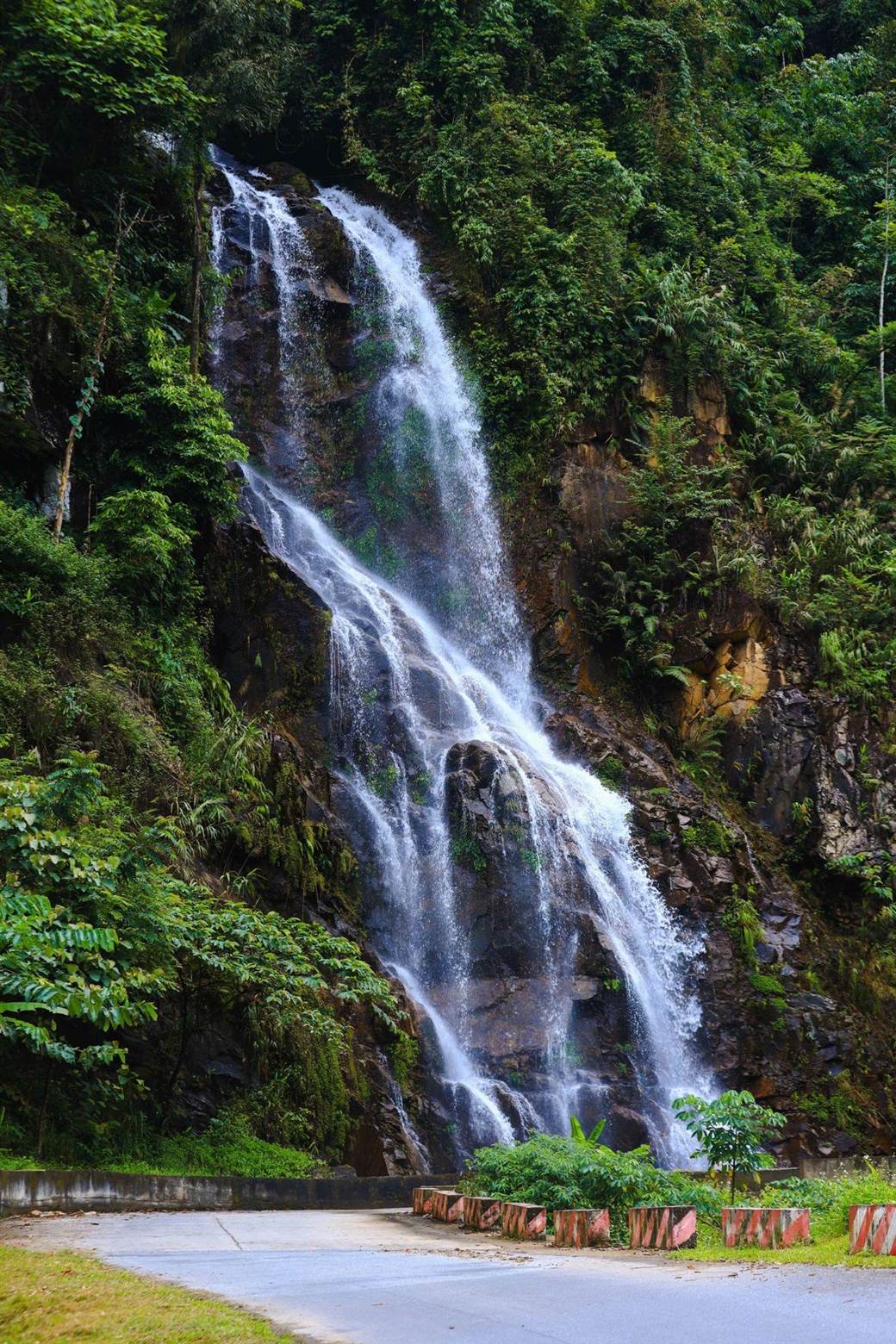
1. Overview: Why Ha Giang Loop is a Waterfall Wonderland
The Ha Giang Loop’s distinctive geology and climate create perfect conditions for some of Vietnam’s most spectacular waterfalls. Unlike the country’s more commercialized cascades, the falls here maintain a wild, untamed character that rewards adventurous travelers.
1.1 Geological formation and natural context
Ha Giang’s landscape was shaped over millions of years as tectonic movements pushed marine limestone beds upward, creating the dramatic karst plateau we see today. The region’s abundant rainfall and steep elevation changes have carved countless streams and rivers through this limestone foundation. When these waterways encounter changes in elevation, they create the magnificent waterfalls scattered throughout the loop.
The province receives approximately 2,300mm of rainfall annually, concentrated during the monsoon season. This precipitation feeds an extensive network of underground and surface waterways, with many streams remaining full year-round due to the surrounding forests’ natural water retention. As water flows from the highlands toward the valleys, it creates cascades ranging from gentle tiers of water to powerful single-drop falls plunging into emerald pools.
1.2 Best time of year for waterfalls
For waterfall enthusiasts, timing your Ha Giang Loop adventure is crucial. The waterfalls show distinctly different characters throughout the year, offering varied experiences depending on when you visit.
The rainy season (May to September) transforms the waterfalls into thunderous displays of nature’s power. During these months, especially July and August, the increased water volume creates dramatic, photogenic cascades with maximum flow. However, this period also brings challenges – access roads can become slippery, and some falls might be too dangerous for swimming due to strong currents and reduced visibility in the water.
The dry season (October to April) offers a more accessible and intimate waterfall experience. While the water volume decreases, many falls retain significant flow thanks to underground springs. The reduced current allows for safe swimming in designated spots, and the clearer water reveals stunning blue-green colors. Additionally, the moderate weather makes hiking to remote falls more comfortable, with temperatures ranging from 15-25°C during the day.
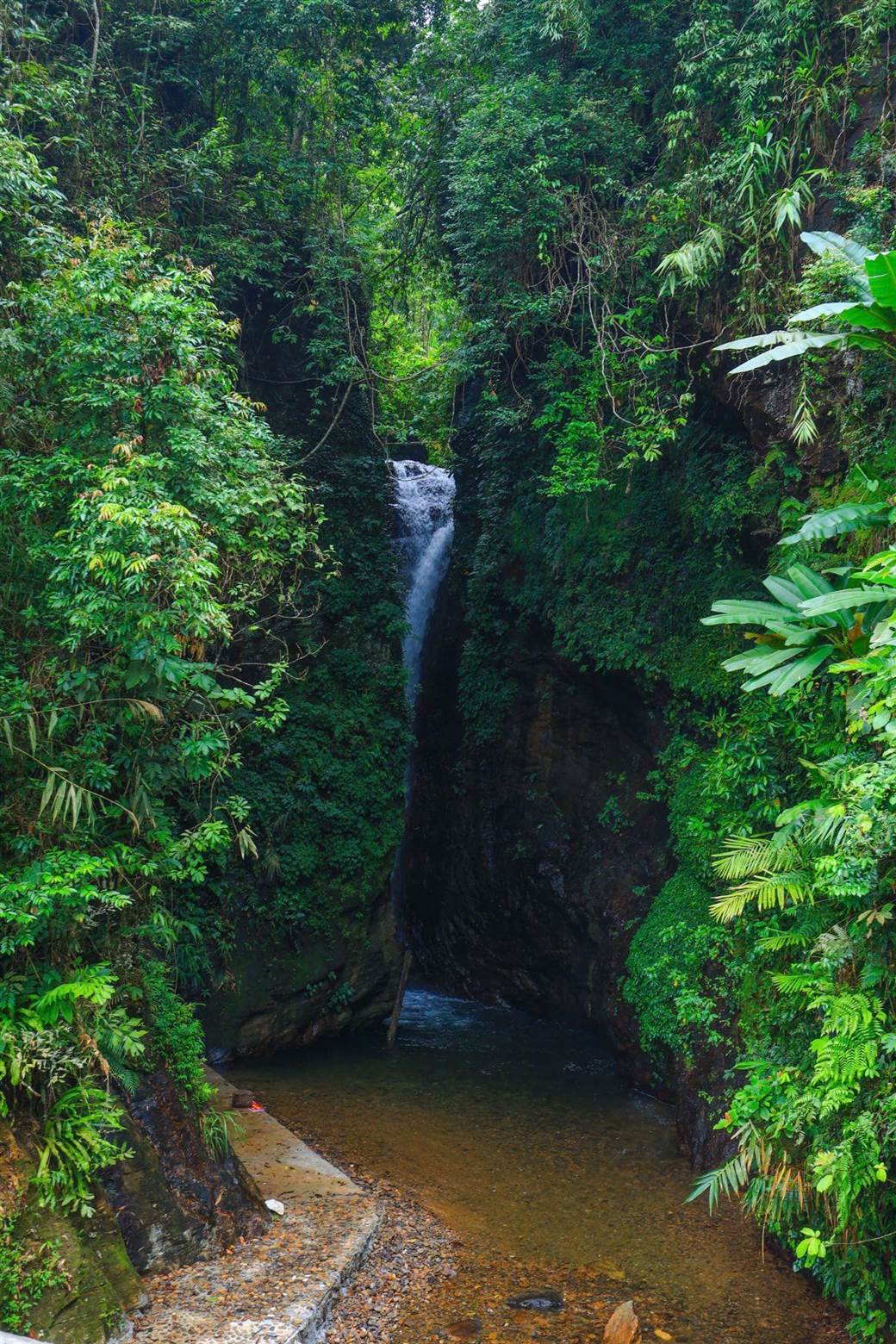
2. Top Waterfalls You Can’t Miss
Ha Giang’s diverse waterfall network ranges from easily accessible roadside cascades to hidden gems requiring challenging treks. Each offers its own unique character and experience.
2.1 Du Gia Waterfall: The Loop’s most accessible natural pool
Just a short walk from Du Gia village in Yen Minh district, Du Gia Waterfall has become one of the most popular water attractions on the Ha Giang Loop. The waterfall features multiple tiers cascading approximately 30 meters down a forested hillside before collecting in a clear, emerald pool perfect for swimming.
What makes Du Gia special is its accessibility combined with natural beauty. Unlike some falls requiring challenging hikes, Du Gia is reachable via an easy 15-minute walk from the village center. The trail passes through terraced rice fields before entering a forested area that opens to reveal the cascades. Despite its proximity to the village, the waterfall maintains a pristine atmosphere with facilities tastefully integrated into the natural environment.
The swimming area at Du Gia is relatively safe during the dry season, with a depth of 1-2 meters in the main pool. Local entrepreneurs have constructed small bamboo platforms and basic changing facilities to support visitors. For the best experience, arrive early in the morning (before 9:00 AM) to avoid crowds and enjoy the serene atmosphere that has made this waterfall a highlight for travelers discovering the loop’s natural wonders.
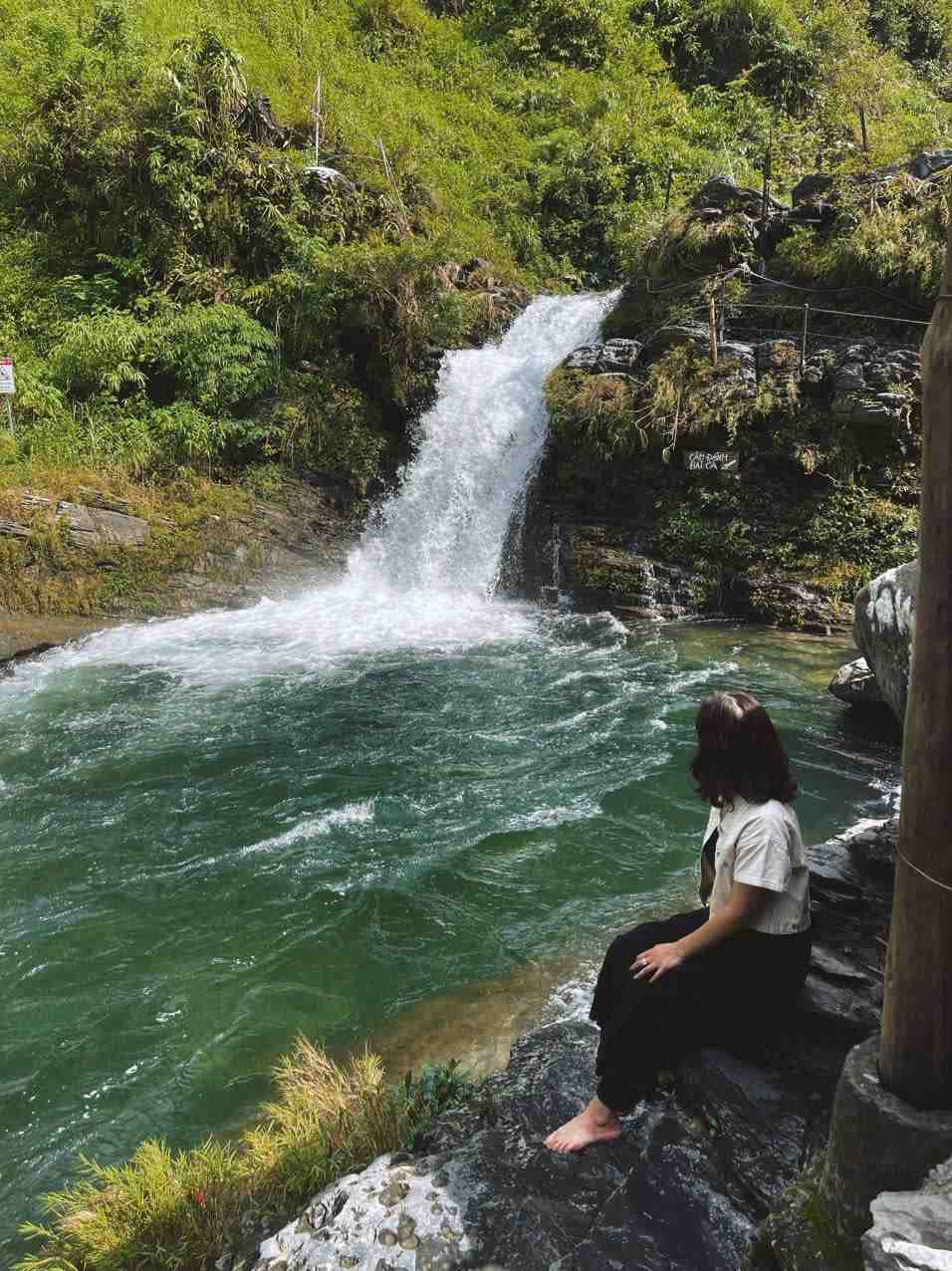
2.2 Nai Waterfall: The secluded cascade of Nam Dam
Located near Nam Dam village in Quan Ba district, Nai Waterfall is one of the most charming yet lesser-known cascades on the Ha Giang Loop. The waterfall plunges around 30 meters into a crystal-clear pool framed by limestone cliffs and dense forest, creating a tranquil spot that feels worlds away from the busy loop roads.
Reaching Nai requires a 20–25 minute trek from the village, following a forested trail that winds past terraced rice fields and Dao ethnic houses. This short hike makes the arrival even more rewarding, as the sound of rushing water grows louder with each step before the falls finally reveal themselves.
The best months to visit are March–May and September–November, when the weather is pleasant and the trail conditions stable. During the rainy season, the waterfall becomes more dramatic, though access can be slippery. In the dry season, the pool below is ideal for swimming and cooling off.
A visit to Nai is often paired with exploring Nam Dam village, where Dao families welcome travelers with homestays, traditional weaving, and mountain cuisine. This blend of nature and culture makes Nai Waterfall a true hidden gem of the Ha Giang Loop.
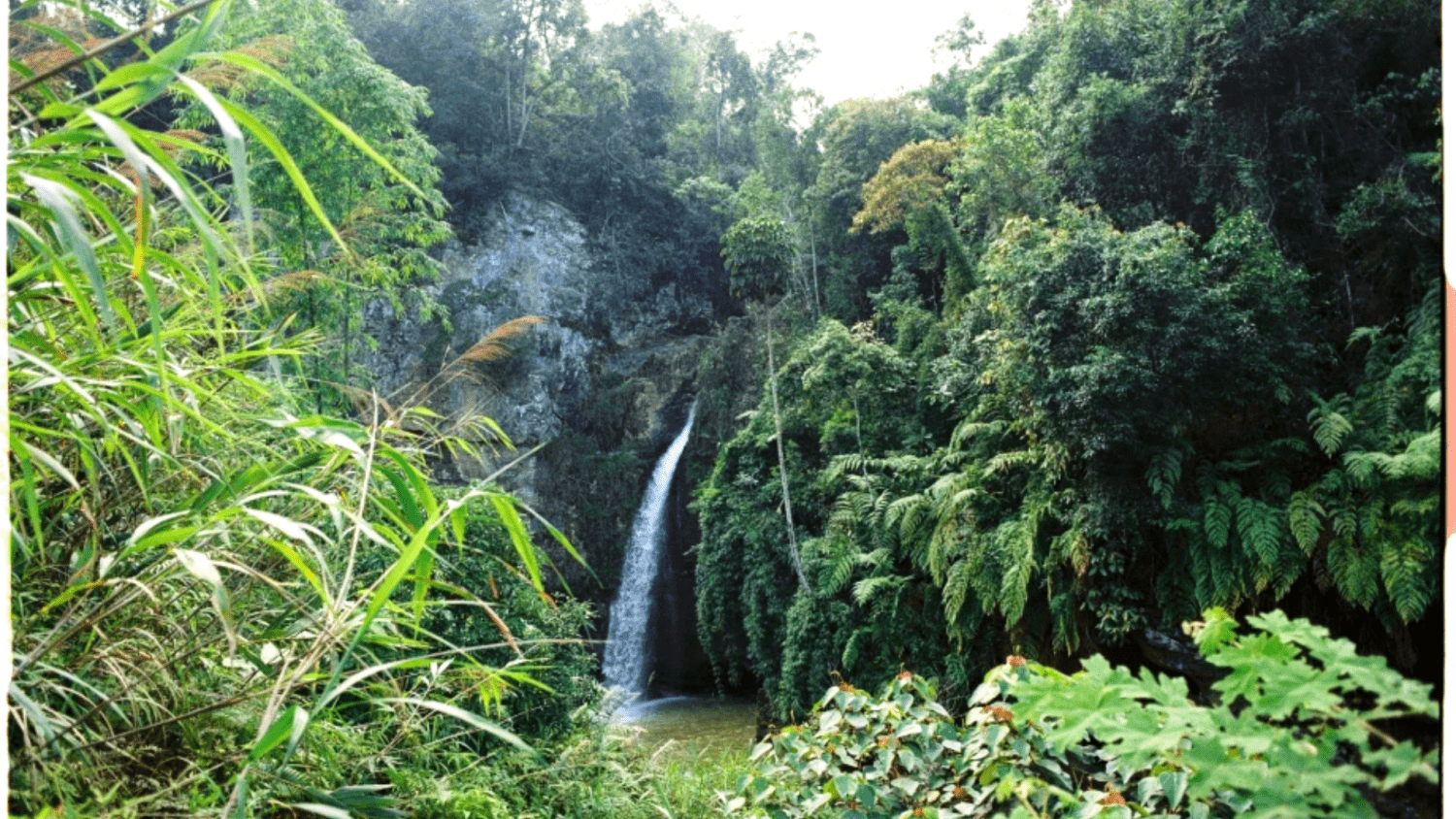
2.3 Nam Tau Waterfall: Adventure seeker’s paradise
Hidden in the forests near Nam Dam village in Quan Ba district, Nam Tau Waterfall rewards adventurous travelers with one of Ha Giang’s most pristine natural experiences. Unlike more developed falls, Nam Tau maintains a wild, untouched character that appeals to those seeking authentic connections with nature.
The waterfall drops approximately 40 meters through a narrow gorge before widening at the base into a series of smaller cascades and clear pools. The surrounding forest creates a microclimate around the falls, with moss-covered rocks and abundant ferns giving the area a prehistoric atmosphere. The water appears distinctly silver-blue, a result of minerals dissolved from the limestone bedrock.
Reaching Nam Tau requires commitment – a challenging 5km trek from Nam Dam village that takes approximately 2 hours each way. The trail crosses streams and winds through dense forest with occasional steep sections. This difficulty has preserved the falls’ pristine state, as only determined travelers make the journey. For overnight adventures, small camping areas exist near the base of the falls, though visitors must bring all necessary supplies and practice strict leave-no-trace principles.
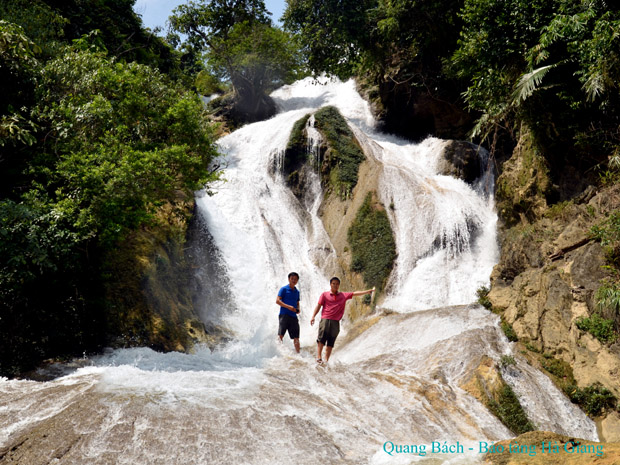
2.4 Thi Waterfall: The watersilk beneath Tay Con Linh
Located near the base of Tay Con Linh mountain in Vi Xuyen district, Thi Waterfall (sometimes called Thui Waterfall) offers a unique multi-tiered cascade flowing like a silk ribbon down a forested hillside. The fall’s distinctive feature is its wide, sheet-like flow that spreads across a broad rock face, creating a gentle curtain of water approximately 50 meters high.
Local Tay and Dao communities consider Thi Waterfall sacred, believing mountain spirits reside in the clear pools at its base. According to legend, young women would once visit the falls to pray for good husbands, leaving offerings of colorful cloth that resembled the waterfall’s silky flow. This cultural significance adds depth to the natural beauty, making it a place of both scenic and spiritual importance.
The falls lie approximately 30km from Ha Giang City, accessible via a combination of driving and a moderate 2km hike. The trail passes through Tay villages and terraced fields before entering forest, providing cultural context for the natural attraction. The final approach reveals the falls gradually, with each turn offering increasingly impressive views before the full cascade comes into sight.
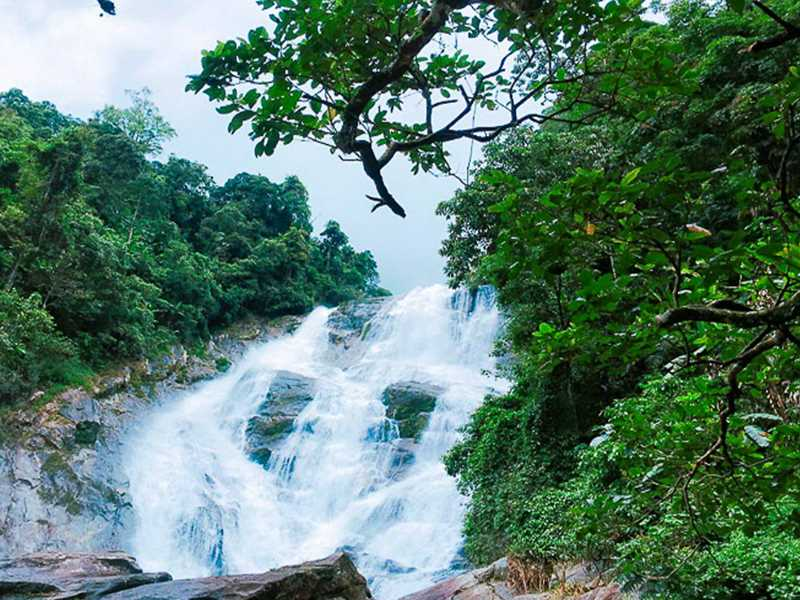
2.5 Khau Lan Waterfall: The Untamed Cascade of Ha Giang
Hidden deep in the Yen Minh forests, Khau Lan Waterfall remains one of Ha Giang’s most unspoiled natural wonders. The cascade plunges dramatically through layers of limestone cliffs, creating misty veils that shimmer under the sunlight.
Unlike the more visited falls of Du Gia or Quan Ba, Khau Lan demands a bit of adventure. The trek to reach it leads you through dense jungle paths, bamboo groves, and remote hamlets, offering an authentic glimpse of local life along the Ha Giang Loop.
During the rainy season, Khau Lan surges with power, while in the dry months, its crystal-clear pools invite travelers to pause for a refreshing swim. For those seeking a raw, untamed side of Ha Giang, Khau Lan Waterfall is a highlight not to be missed.
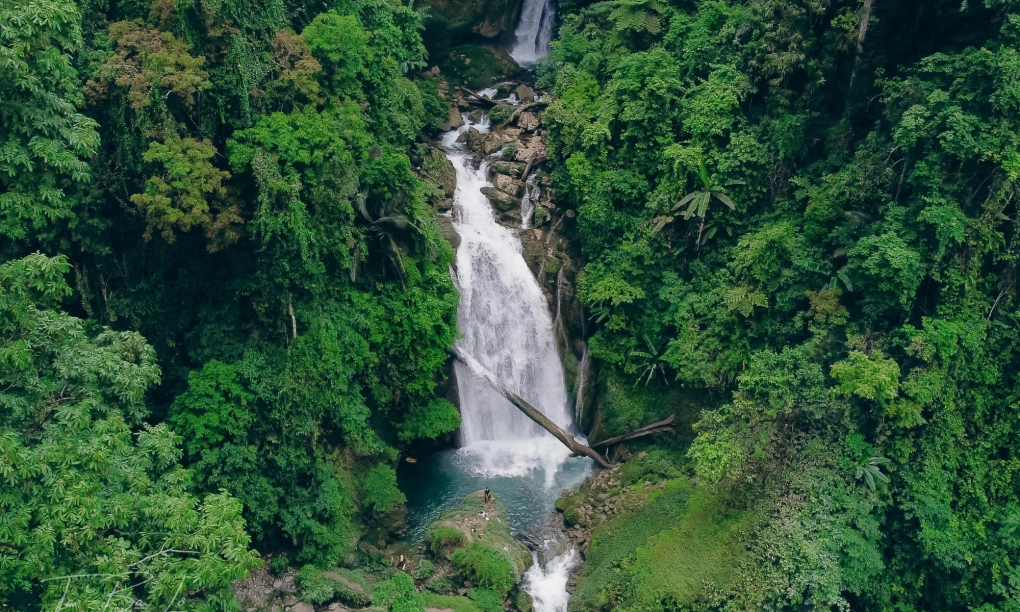
3. How to Access Each Waterfall
Navigating to Ha Giang’s waterfalls requires planning and sometimes local guidance. Transportation options and trail conditions vary significantly between locations.
3.1 Route mapping & transport options
The main transportation challenge in Ha Giang is balancing flexibility with safety. While motorbikes offer the freedom to reach remote trailheads, the region’s challenging roads demand experienced riders. For those less confident on two wheels, alternative arrangements can make waterfall exploration accessible.
For reaching Du Gia Waterfall, the most straightforward approach starts from Du Gia village, which connects to the main loop via a 16km detour from National Road 4C. From the village center, follow the signed footpath south for approximately 800 meters. This fall is accessible year-round, though the dirt path becomes muddy after heavy rain.
Nam Tau Waterfall requires more commitment. From Ha Giang city, travel to Quan Ba district and continue to Nam Dam village. At the village, arrange a local guide (approximately 200,000-300,000 VND) to lead you along the unmarked forest trail. A 4WD vehicle or motorbike with good clearance is necessary to reach the trailhead during rainy periods.
Thi Waterfall is relatively accessible by vehicle, with parking available approximately 2km from the falls. From Ha Giang city, follow Highway 2 toward Vi Xuyen for about 25km, then turn at the signed junction toward Tay Con Linh mountain. The final approach requires a moderate hike on a well-maintained trail.
Khau Lan Waterfall presents the greatest access challenge. Located 7km from the nearest paved road, reaching the trailhead requires navigating rough dirt tracks passable only by motorbike or 4WD during dry conditions. Local guides from nearby Dao villages are essential, as the trail crosses private property and contains several unmarked junctions.
3.2 Safety and navigation tips
Ha Giang’s remote location and limited emergency services make safety preparation essential for waterfall expeditions. Planning ahead can prevent problems and ensure an enjoyable experience.
Always check weather forecasts before departing. Flash floods pose serious dangers, especially during the rainy season (May-September). If heavy rain occurs or is predicted, postpone visits to waterfalls located in narrow gorges like Nam Tau or Khau Lan. Remember that storms in the mountains can cause dangerous water surges downstream, even when conditions appear calm at your location.
Download offline maps before your trip, as cellular coverage remains spotty throughout the region. Applications like Maps.me or Google Maps with downloaded areas provide basic navigation even without signal. Mark key landmarks and junctions when parking vehicles, as many trailheads lack formal designation.
Consider hiring local guides for accessing remote falls. Beyond navigation, guides provide cultural context and ensure respectful interactions with ethnic communities whose land you traverse. Phieu Travel can arrange guides experienced with specific waterfall routes, typically costing 300,000-500,000 VND per day depending on difficulty.
Tell someone your plans before departing for remote locations. Provide your expected return time and route to your accommodation host or travel companions. This simple precaution ensures someone will raise an alarm if you encounter difficulties.
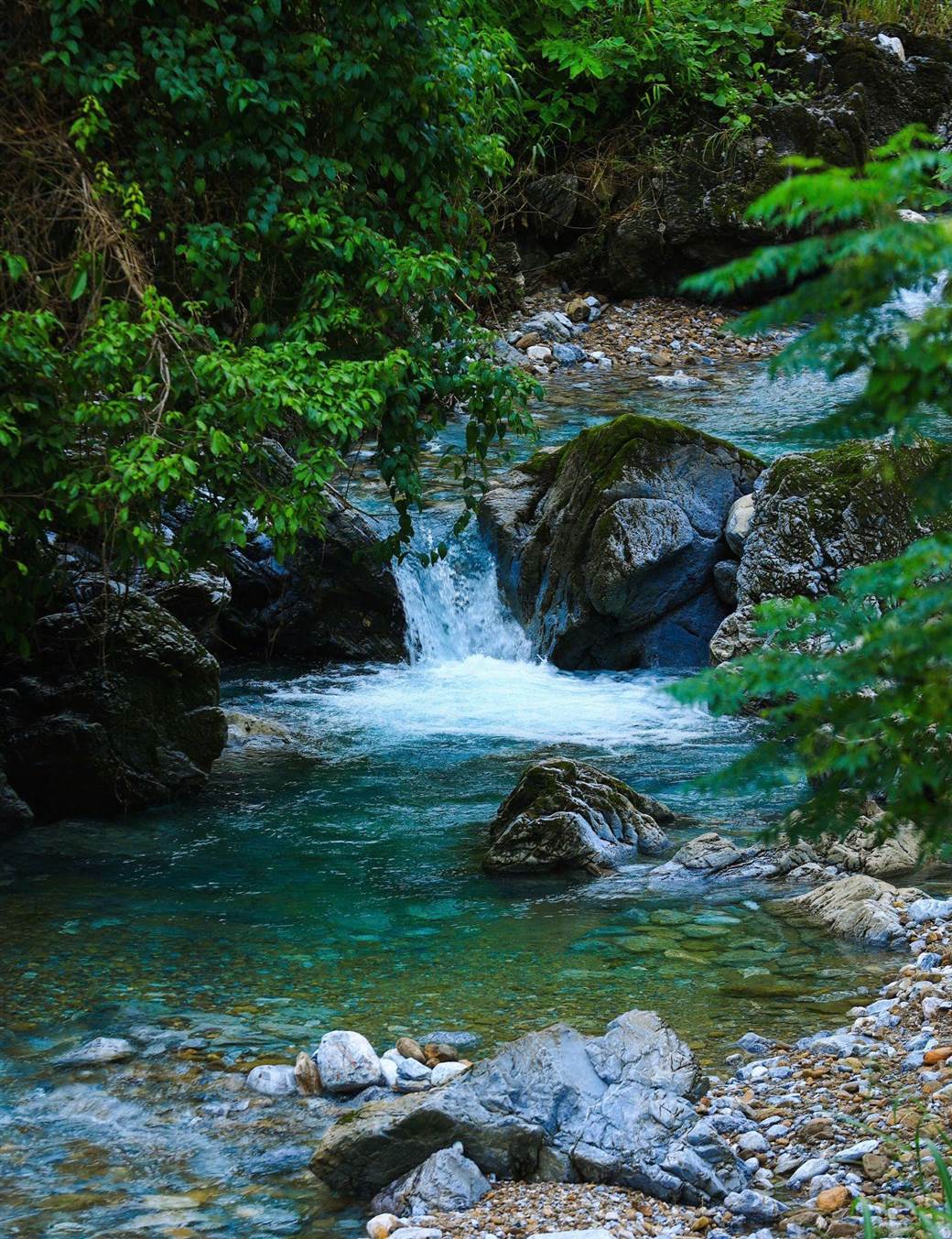
Conquer Tay Con Linh Peak – Ha Giang’s Highest Mountain 2025
4. Activities at Ha Giang Loop Waterfalls
The waterfalls of Ha Giang offer more than just scenic views – they provide environments for varied activities suited to different traveler preferences.
4.1 Swimming, trekking, photo spots
Swimming ranks among the most popular waterfall activities, providing welcome refreshment after hot treks or motorcycle rides. Du Gia Waterfall offers the most accessible and safest swimming, with its wide, relatively shallow main pool and gradually sloping entry points. Local families often picnic here on weekends, creating a festive atmosphere during warmer months.
For photography enthusiasts, each waterfall presents unique compositional opportunities. Thi Waterfall’s wide cascade creates dreamy long-exposure possibilities, especially in early morning light when mist often surrounds the falls. Nam Tau’s deep forest setting benefits from mid-afternoon shooting when filtered sunlight illuminates the water without harsh contrast. Tripods prove essential for capturing silky water effects, particularly at lower-light locations like Khau Lan.
Trekking opportunities vary from casual walks to challenging adventures. Beyond the main falls, explorers can follow upstream or downstream paths to discover smaller cascades and private pools. The 3km stretch below Du Gia Waterfall contains several additional tiers rarely visited by tourists. Similarly, a challenging scramble above Thi Waterfall reveals upper cascades with panoramic valley views.
Adventure seekers can arrange canyoning expeditions at select locations. While not commercially developed, guides from Phieu Travel can organize basic canyoning at Nam Tau Waterfall, including rappelling alongside the main drop. These activities require advance arrangement and suitable weather conditions.
4.2 Responsible tourism & safety tips
As Ha Giang’s popularity grows, practicing responsible tourism becomes increasingly important to preserve these natural wonders for future generations. Sustainable practices benefit both the environment and local communities.
Follow leave-no-trace principles when visiting waterfalls. Pack out all trash, including seemingly biodegradable items like fruit peels that aren’t native to the area. Avoid using soap or shampoo directly in the water, as chemicals harm sensitive aquatic ecosystems. If camping near falls, use established sites and keep fires small and controlled when permitted.
Respect privacy and cultural norms when waterfalls pass through or near ethnic villages. Many communities maintain spiritual connections to these natural features. Ask permission before photographing people, homes, or religious sites. If visiting falls with cultural significance like Thi Waterfall, observe local customs regarding appropriate behavior and any restrictions.
For swimming safety, never dive from rocks without checking water depth and obstacles. Currents can be surprisingly strong, especially after rain. Assess your swimming abilities honestly and stay within comfortable depths. Even during dry season, flash floods can occur from distant rainfall – if water color changes suddenly or levels rise, exit immediately.
Always wear appropriate footwear for waterfall treks. Paths frequently become slippery, especially near the falls where algae grow on rocks. Non-marking trail shoes or sandals with good grip provide necessary traction while minimizing environmental impact. Bring a small first aid kit for minor injuries, as medical facilities remain distant from most waterfall locations.
5. Local Culture, Myths, and Community Insights
Ha Giang’s waterfalls aren’t merely natural features but living parts of local cultural landscapes. Understanding the human connections enriches your experience beyond scenic appreciation.
5.1 Folk stories attached to the falls
Across Ha Giang, ethnic communities have woven waterfalls into their mythology and daily life for generations. These stories reveal how natural features shape cultural identity and traditional beliefs.
Among the Hmong communities near Du Gia, waterfalls represent the tears of Sky Mother, who wept when her children (humanity) chose to live on Earth rather than return to the heavens. Each cascade commemorates her continuing love for humans despite their decision. Elders claim that drinking from waterfall pools brings wisdom and connection to ancestors who have returned to the spiritual realm.
The Dao people living near Nam Tau Waterfall believe a powerful dragon lives beneath the largest pool, governing rainfall and crop success. During traditional new year ceremonies, shamans sometimes visit the falls to communicate with this spirit, requesting favorable conditions for the coming agricultural season. Small shrines occasionally appear near the waterfall base, containing offerings of rice wine and cloth.
Thi Waterfall features prominently in Tay courtship traditions. Young men once demonstrated courage by collecting special ferns growing on inaccessible rocks beside the falls. These plants, believed to possess romantic magic, would be presented to potential brides. Couples who married after such gifts were thought to enjoy particularly harmonious relationships blessed by the waterfall spirits.
Even today, locals often show reverence when approaching major falls, with subtle gestures like touching water to their foreheads or leaving small offerings of rice or flowers. Recognizing and respecting these continuing practices demonstrates cultural sensitivity during your visit.
5.2 Visiting local villages responsibly
Many Ha Giang waterfalls flow through or near ethnic minority villages, creating opportunities for cultural exchange but also requiring thoughtful visitor behavior. Approaching these interactions with respect ensures positive experiences for both travelers and communities.
Before visiting villages near waterfalls, learn basic greetings in the local language. Simple phrases show respect and open doors to meaningful interactions. The Dao “A vay” (hello) or Hmong “Nyob zoo” (hello) often elicit smiles and appreciation for your effort, even if pronunciation isn’t perfect.
Dress modestly when passing through villages, especially in more traditional communities. Shoulders and knees covered represent minimum expectations. Remove shoes when invited into homes, and accept offered tea as a gesture of hospitality, even if you only take a symbolic sip.
Support local economies directly by purchasing handicrafts or services from waterfall-adjacent communities. Many villages produce distinctive textiles, baskets, or food products that make meaningful souvenirs while providing income. Near Du Gia Waterfall, Hmong women sell traditional embroidery, while Dao villages near Nam Tau offer medicinal herbs and honey collected from surrounding forests.
Seek permission before photographing people or private property. If language barriers exist, gesture with your camera and wait for affirmative responses. Photography inside ritual spaces or of religious ceremonies may be restricted – always follow local guidance on sensitive locations.
Phieu Travel arranges cultural exchange opportunities with communities near major waterfalls, including home-cooked meals and demonstrations of traditional skills. These structured interactions ensure fair compensation while providing authentic insights into daily life beyond tourist superficialities.
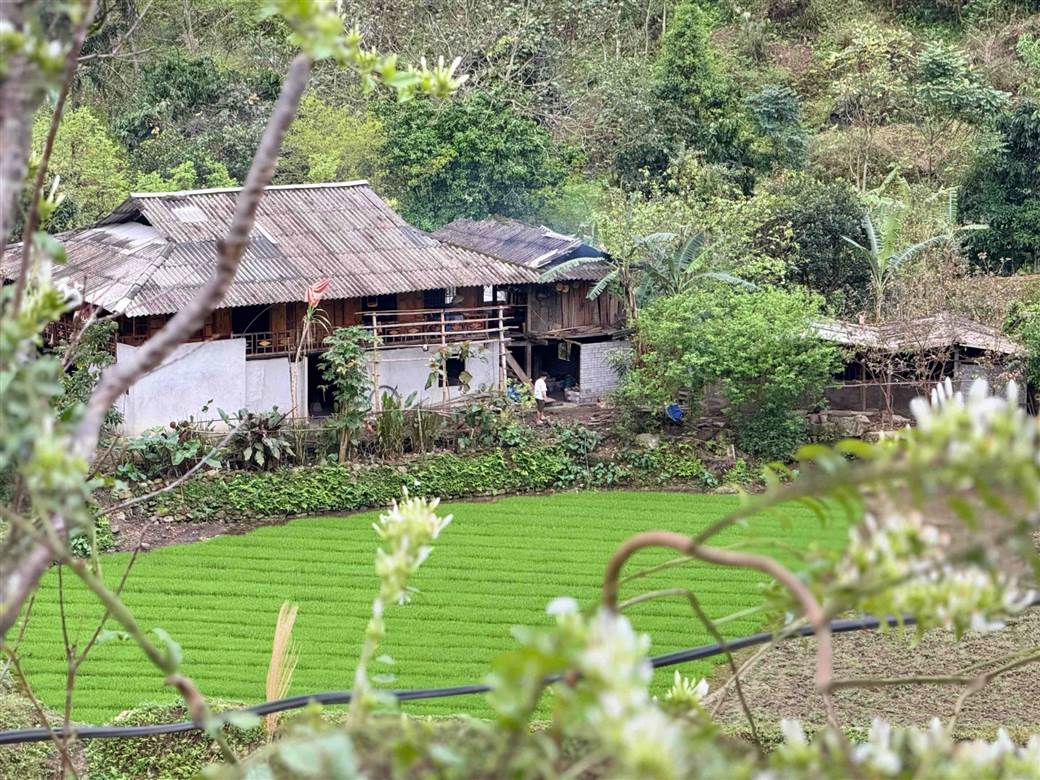
6. Essential Tips & Packing Guide
Proper preparation maximizes enjoyment and safety during waterfall exploration in Ha Giang’s remote terrain. Knowing what to bring and what to leave behind makes the difference between memorable adventures and frustrating challenges.
6.1 Gear recommendations
Waterfall visits require specialized equipment beyond standard Ha Giang Loop packing. These essential items address the unique conditions encountered at cascade sites.
For footwear, pack quick-drying trail sandals with good grip (like Teva or Keen models) for water crossings and swimming, plus closed hiking shoes for longer approaches. Flip-flops prove inadequate for most waterfall terrain and can become dangerous on slippery surfaces.
Protect electronics with waterproof cases or dry bags, especially cameras and phones. Even falls you don’t plan to swim in generate considerable spray that can damage unprotected devices. Waterproof phone pouches with lanyards provide convenient protection while allowing photography.
Pack a quick-dry microfiber towel that compresses small but absorbs effectively. Traditional cotton towels remain wet for hours and add unnecessary weight. Similarly, consider quick-dry clothing (nylon/polyester blends) that performs better than cotton in humid environments.
Sun protection remains essential despite forested approaches to many falls. Waterfall clearings often expose visitors to direct sunlight reflected off water surfaces, intensifying UV exposure. Bring waterproof sunscreen, a brimmed hat, and UV-protective sunglasses.
For multi-tier falls requiring climbing between levels, a small daypack with water bottle attachment keeps hands free for scrambling. Include basic first aid supplies focusing on treatments for scrapes, insect bites, and minor sprains the most common waterfall-related injuries.
6.2 Hiring guides
Local guides enhance waterfall experiences through knowledge, safety, and cultural mediation. Understanding when and how to hire guides ensures quality experiences.
For easily accessible falls like Du Gia, guides remain optional but can enrich your experience through cultural and natural interpretation. For remote locations like Nam Tau or Khau Lan, local guides become essential due to unmarked trails, private property crossings, and safety considerations.
Reputable guides typically charge 300,000-500,000 VND per day depending on difficulty and group size. While budget-conscious travelers might consider this optional, the value extends beyond simple navigation. Guides explain ecosystem features, identify wildlife, and facilitate positive interactions with local communities while ensuring your impact remains minimal.
To find qualified guides, arrange through established businesses rather than accepting random offers. Phieu Travel maintains relationships with guides from various ethnic communities around Ha Giang, matching visitor interests with appropriate expertise. When hiring independently, verify that guides carry basic safety equipment and possess genuine local knowledge ask specific questions about the falls to assess their familiarity.
Even with guides, maintain reasonable expectations about English proficiency. While many guides speak basic English, complex conversations may require patience or translation apps. This language gap rarely diminishes the experience, as guides excel in showing rather than telling pointing out hidden features, demonstrating safe passages, and modeling appropriate behavior around cultural sites.
6.3 Seasonal/weather concerns
Ha Giang’s dramatic seasonal variations significantly impact waterfall experiences. Understanding these patterns helps plan appropriate visits with realistic expectations.
The rainy season (May-September) transforms waterfalls to their most spectacular volume but introduces significant challenges. Trails become treacherously slippery, leeches emerge in forested areas, and flash flood risks increase substantially. Water clarity diminishes as runoff carries sediment, sometimes giving falls a brownish appearance rather than the crystal blue of drier months.
During peak rainy months (July-August), some waterfall trails close entirely due to safety concerns. Others require guides even if normally accessible independently. Plan flexible itineraries during this period, with backup options when weather prevents certain visits. Morning excursions offer better chances of completion before afternoon thunderstorms typically develop.
The dry season (October-April) provides more reliable access with clearer water and stable trail conditions. Water volume decreases progressively, with January-March seeing minimum flow at some smaller falls. Photography during these months benefits from better light penetration through forest canopies and the emerald-blue water colors produced by concentrated minerals.
Regardless of season, mountain weather changes rapidly. Pack rain protection year-round and dress in easily adjusted layers. Check weather forecasts before departing, with special attention to rainfall predictions for areas upstream from your destination heavy rain in the mountains can cause dangerous conditions at falls below, even under clear skies.
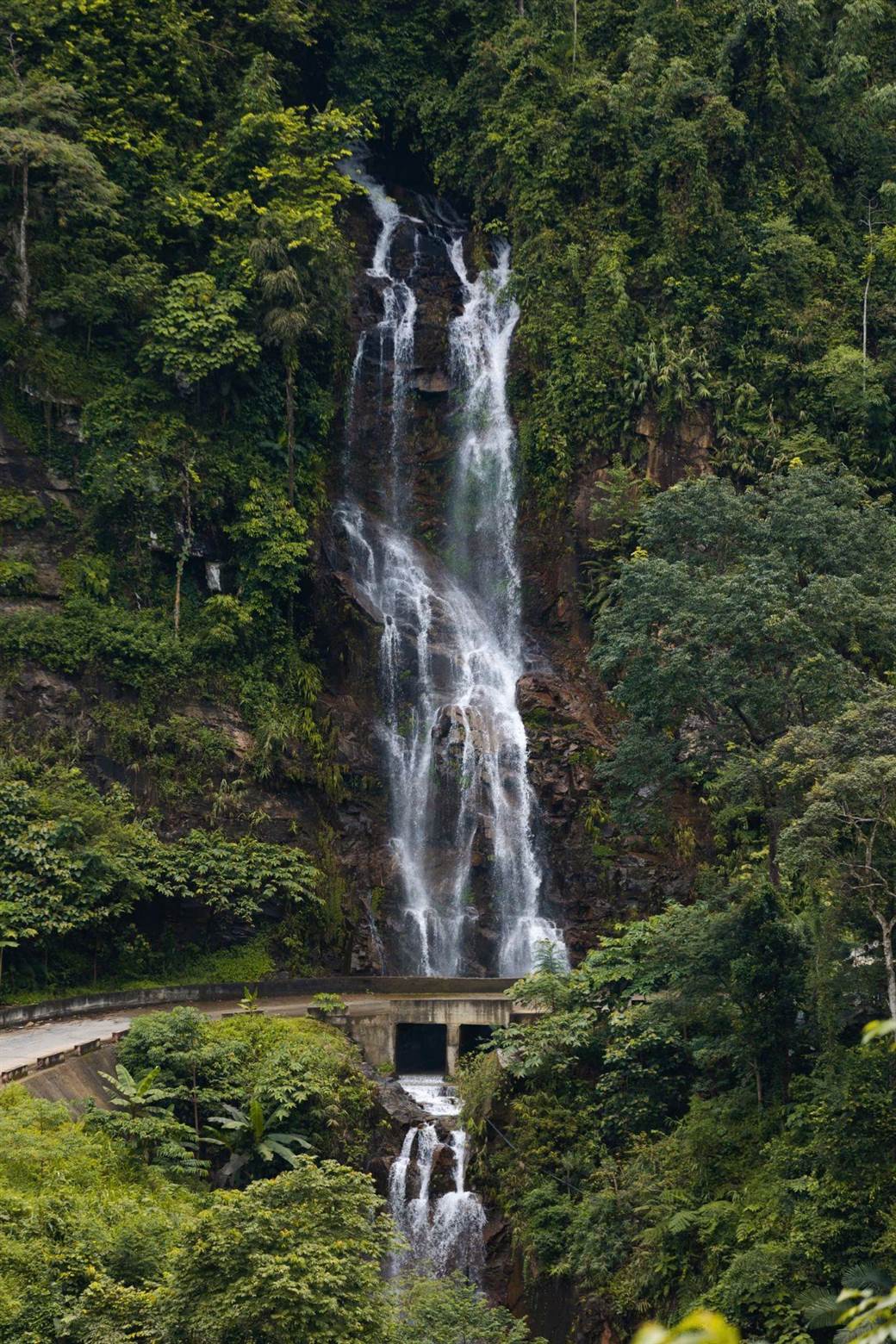
The waterfalls on the Ha Giang Loop offer refreshing counterpoints to the region’s mountainous landscapes and cultural experiences. From accessible cascades like Du Gia to remote treasures like Nam Tau, these natural features provide memorable moments of connection with Vietnam’s stunning northern wilderness.
When planning your Ha Giang adventure, consider allocating specific days for waterfall exploration rather than trying to squeeze brief visits between major road sections. The most rewarding experiences come from unhurried immersion time for swimming, photography, and simply absorbing the peaceful atmosphere these natural wonders create. A comprehensive Ha Giang itinerary might dedicate day three to Du Gia Waterfall and surroundings, allowing full enjoyment without rushing back to the main route.
Balancing famous and lesser-known waterfalls creates the most satisfying experience. While Du Gia deserves its popularity, allocating time for at least one off-the-beaten-path cascade rewards you with solitude and more intimate nature connection. The contrast between these experiences highlights the diversity of Ha Giang’s waterfall offerings.
For travelers seeking assistance with waterfall-focused Ha Giang itineraries, Phieu Travel specializes in customized routes that incorporate the region’s finest cascades alongside cultural experiences and scenic drives. Their local connections ensure access to hidden gems while maintaining responsible tourism practices that preserve these natural treasures for future generations. Whether you’re planning a standard loop adventure or a specialized waterfall expedition, visit Phieutravel.com for expertly crafted itineraries that reveal the true magic of Ha Giang’s enchanting waterfalls.
Read more:
- Explore Xa Phin Village Ha Giang Tea Culture and Local Life
- Tu San Canyon Ha Giang – Vietnam’s Deepest Canyon Guide
- The Ultimate Guide to Khau Vai Love Market in Ha Giang

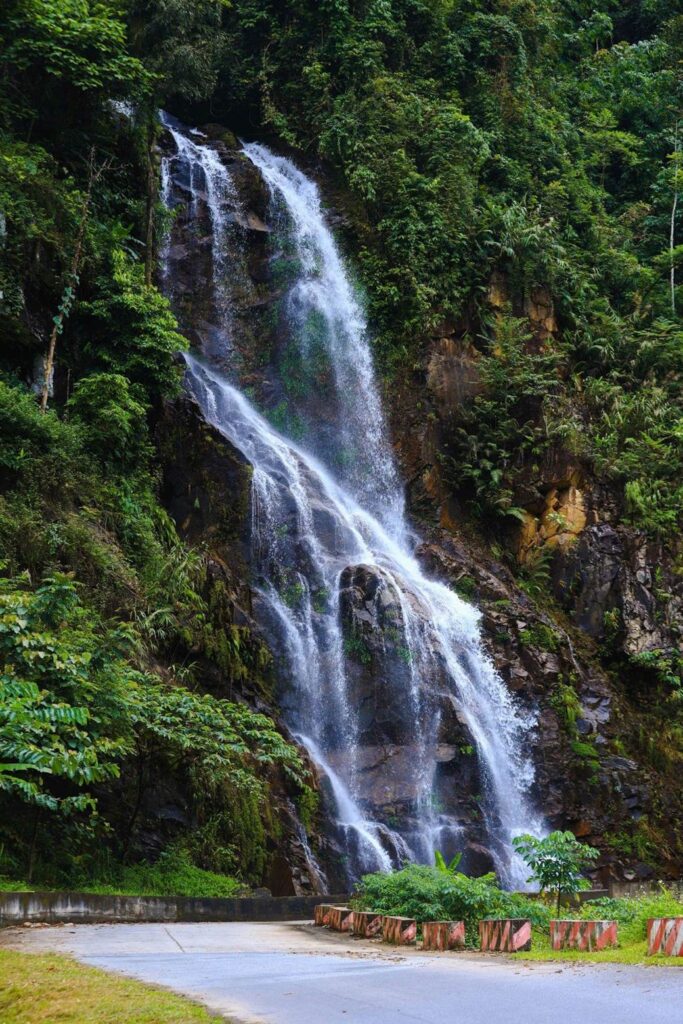
You Might Also Like
Ha Giang Weather in September: Complete Guide for Travelers
Exploring the magnificent Ha Giang Loop in September offers travelers a perfect balance of favorable[...]
Quan Ba Twin Mountains: Ha Giang’s Iconic Fairy Hills and Complete Travel Guide
The mystical Quan Ba Twin Mountains rise from the emerald valleys of Ha Giang like[...]
Vuong family mansion: the architectural marvel and cultural legacy of Ha Giang
Deep in Vietnam’s northern highlands, where mist-shrouded mountains meet terraced rice fields, stands a testament[...]
Ha Giang Loop Safety Tips: How to Ride Securely in Vietnam’s Northern Mountains
The Ha Giang Loop, with its winding mountain roads and breathtaking landscapes, offers one of[...]
The Ultimate Guide to the M-Shaped Curve on Ha Giang Loop
Vietnam’s remote northern province of Ha Giang hides a natural wonder that has captivated adventurous[...]
Most Beautiful Places to Visit in Vietnam: Essential Destinations and Insider Tips
Vietnam captivates travelers with its stunning landscapes, rich cultural heritage, and warm hospitality. From mist-shrouded[...]
Beyond the Beaten Path: Discovering Ha Giang Province in Northeast Vietnam
Ha Giang Province in Northeast Vietnam stands as one of the country’s last frontiers for[...]
Rainy season in Ha Giang: what to expect, when to go, and travel tips
Vietnam’s northern frontier reveals a different face during the rainy season, transforming Ha Giang’s limestone[...]